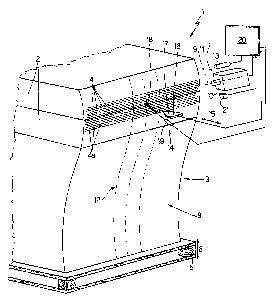Une partie des informations de ce site Web a été fournie par des sources externes. Le gouvernement du Canada n'assume aucune responsabilité concernant la précision, l'actualité ou la fiabilité des informations fournies par les sources externes. Les utilisateurs qui désirent employer cette information devraient consulter directement la source des informations. Le contenu fourni par les sources externes n'est pas assujetti aux exigences sur les langues officielles, la protection des renseignements personnels et l'accessibilité.
L'apparition de différences dans le texte et l'image des Revendications et de l'Abrégé dépend du moment auquel le document est publié. Les textes des Revendications et de l'Abrégé sont affichés :
| (12) Demande de brevet: | (11) CA 2503990 |
|---|---|
| (54) Titre français: | METHODE ET APPAREIL PERMETTANT DE SELECTIONNER ET DE SEPARER LES RAMES D'UNE PILE DE FEUILLES DE PAPIER OU D'ARTICLES SEMBLABLES |
| (54) Titre anglais: | METHOD AND UNIT FOR SELECTING AND SEPARATING REAMS FROM A STACK OF SHEETS OF PAPER OR SIMILAR |
| Statut: | Réputée abandonnée et au-delà du délai pour le rétablissement - en attente de la réponse à l’avis de communication rejetée |
| (51) Classification internationale des brevets (CIB): |
|
|---|---|
| (72) Inventeurs : |
|
| (73) Titulaires : |
|
| (71) Demandeurs : |
|
| (74) Agent: | SMART & BIGGAR LP |
| (74) Co-agent: | |
| (45) Délivré: | |
| (22) Date de dépôt: | 2005-04-07 |
| (41) Mise à la disponibilité du public: | 2005-10-08 |
| Licence disponible: | S.O. |
| Cédé au domaine public: | S.O. |
| (25) Langue des documents déposés: | Anglais |
| Traité de coopération en matière de brevets (PCT): | Non |
|---|
| (30) Données de priorité de la demande: | ||||||
|---|---|---|---|---|---|---|
|
A ream is selected and separated from a stack of
sheets by means of a separating member which is inserted
inside the stack at an insertion region defined by images
acquired by a television camera moved vertically to cover
a given scanning region of the stack; a focused portion
of each image acquired by the television camera being
located as a function of the location in the image of a
line projected onto the stack at an angle of incidence of
other than 90°.
Note : Les revendications sont présentées dans la langue officielle dans laquelle elles ont été soumises.
Note : Les descriptions sont présentées dans la langue officielle dans laquelle elles ont été soumises.

2024-08-01 : Dans le cadre de la transition vers les Brevets de nouvelle génération (BNG), la base de données sur les brevets canadiens (BDBC) contient désormais un Historique d'événement plus détaillé, qui reproduit le Journal des événements de notre nouvelle solution interne.
Veuillez noter que les événements débutant par « Inactive : » se réfèrent à des événements qui ne sont plus utilisés dans notre nouvelle solution interne.
Pour une meilleure compréhension de l'état de la demande ou brevet qui figure sur cette page, la rubrique Mise en garde , et les descriptions de Brevet , Historique d'événement , Taxes périodiques et Historique des paiements devraient être consultées.
| Description | Date |
|---|---|
| Demande non rétablie avant l'échéance | 2009-04-07 |
| Le délai pour l'annulation est expiré | 2009-04-07 |
| Réputée abandonnée - omission de répondre à un avis sur les taxes pour le maintien en état | 2008-04-07 |
| Inactive : CIB de MCD | 2006-03-12 |
| Inactive : CIB de MCD | 2006-03-12 |
| Inactive : CIB de MCD | 2006-03-12 |
| Inactive : CIB de MCD | 2006-03-12 |
| Inactive : CIB de MCD | 2006-03-12 |
| Inactive : CIB de MCD | 2006-03-12 |
| Inactive : CIB de MCD | 2006-03-12 |
| Inactive : CIB de MCD | 2006-03-12 |
| Inactive : CIB de MCD | 2006-03-12 |
| Inactive : CIB de MCD | 2006-03-12 |
| Inactive : CIB de MCD | 2006-03-12 |
| Lettre envoyée | 2005-10-27 |
| Demande publiée (accessible au public) | 2005-10-08 |
| Inactive : Page couverture publiée | 2005-10-07 |
| Inactive : Transfert individuel | 2005-10-05 |
| Inactive : CIB attribuée | 2005-08-18 |
| Inactive : CIB en 1re position | 2005-06-29 |
| Inactive : CIB attribuée | 2005-06-29 |
| Inactive : CIB attribuée | 2005-06-29 |
| Inactive : CIB attribuée | 2005-06-29 |
| Inactive : Lettre de courtoisie - Preuve | 2005-05-24 |
| Inactive : Certificat de dépôt - Sans RE (Anglais) | 2005-05-17 |
| Demande reçue - nationale ordinaire | 2005-05-16 |
| Date d'abandonnement | Raison | Date de rétablissement |
|---|---|---|
| 2008-04-07 |
Le dernier paiement a été reçu le 2007-03-19
Avis : Si le paiement en totalité n'a pas été reçu au plus tard à la date indiquée, une taxe supplémentaire peut être imposée, soit une des taxes suivantes :
Les taxes sur les brevets sont ajustées au 1er janvier de chaque année. Les montants ci-dessus sont les montants actuels s'ils sont reçus au plus tard le 31 décembre de l'année en cours.
Veuillez vous référer à la page web des
taxes sur les brevets
de l'OPIC pour voir tous les montants actuels des taxes.
| Type de taxes | Anniversaire | Échéance | Date payée |
|---|---|---|---|
| Taxe pour le dépôt - générale | 2005-04-07 | ||
| Enregistrement d'un document | 2005-10-05 | ||
| TM (demande, 2e anniv.) - générale | 02 | 2007-04-10 | 2007-03-19 |
Les titulaires actuels et antérieures au dossier sont affichés en ordre alphabétique.
| Titulaires actuels au dossier |
|---|
| KPL PACKAGING S.P.A. |
| Titulaires antérieures au dossier |
|---|
| ANDREA CINOTTI |
| GABRIELE CANINI |